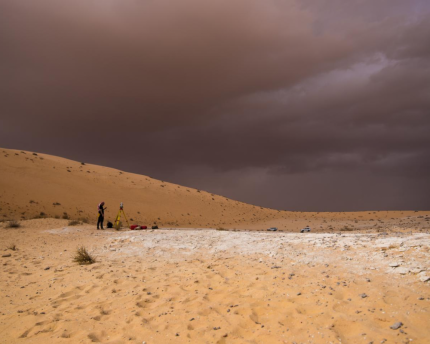Bone discovery fuels new thoughts about history

A researcher surveys the Al Wusta site.
Image: Klint Janulis
And a new study finds that the movement of early humans out of Africa and into Eurasia was more expansive than previously thought.
The story starts with a clue, in this case, a bone -- a 90,000-year-old fossilized finger bone of an early human found in the Nefud Desert of Saudi Arabia. This bone is the oldest homo sapiens fossil discovered outside of Africa and the Levant (Eastern Mediterranean), according to the Max Planck Institute in Germany.
Previously, scientists thought early attempts by humans to move into Eurasia were unsuccessful, and that they remained in the forests of the Levant. Now, scientists believe there were multiple trips out of Africa, and early humans traveled farther than previously thought.
The discovery was made at the site of Al Wusta, an ancient freshwater lake in what is now the hyper-arid Nefud Desert. “Numerous animal fossils, including those of hippopotamus and tiny fresh water snails were found at Al Wusta, as well as abundant stone tools made by humans,” a press release by the institute explains.
But scientists also found a 3.2-centimeter long fossil (a little more than 1 inch) that they recognized as a finger bone. Tests showed the bone was human.
Advanced scientific techniques have been changing what we know of early human history and prehistory. In 2016, research published in the journal Nature reported that the first Americans were unlikely to have crossed a land bridge from Siberia to Alaska -- as taught in schools for years.
Related:
Textbooks wrong about ‘corridor’ route
Water wiped out Europe’s land bridge
Follow StudyHall.Rocks on Twitter.
If you would like to comment, give us a shout, or like us on Facebook and tell us what you think.

